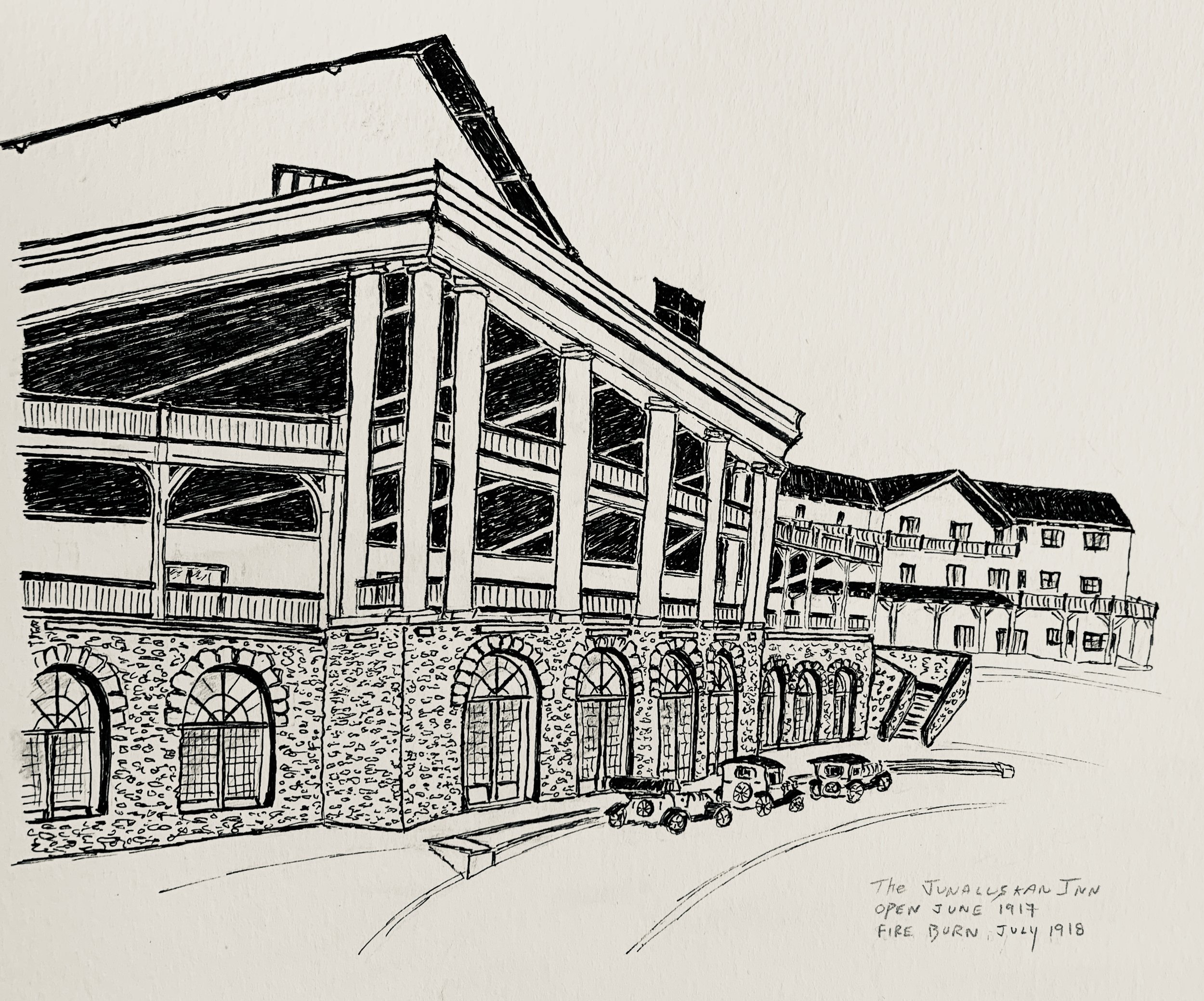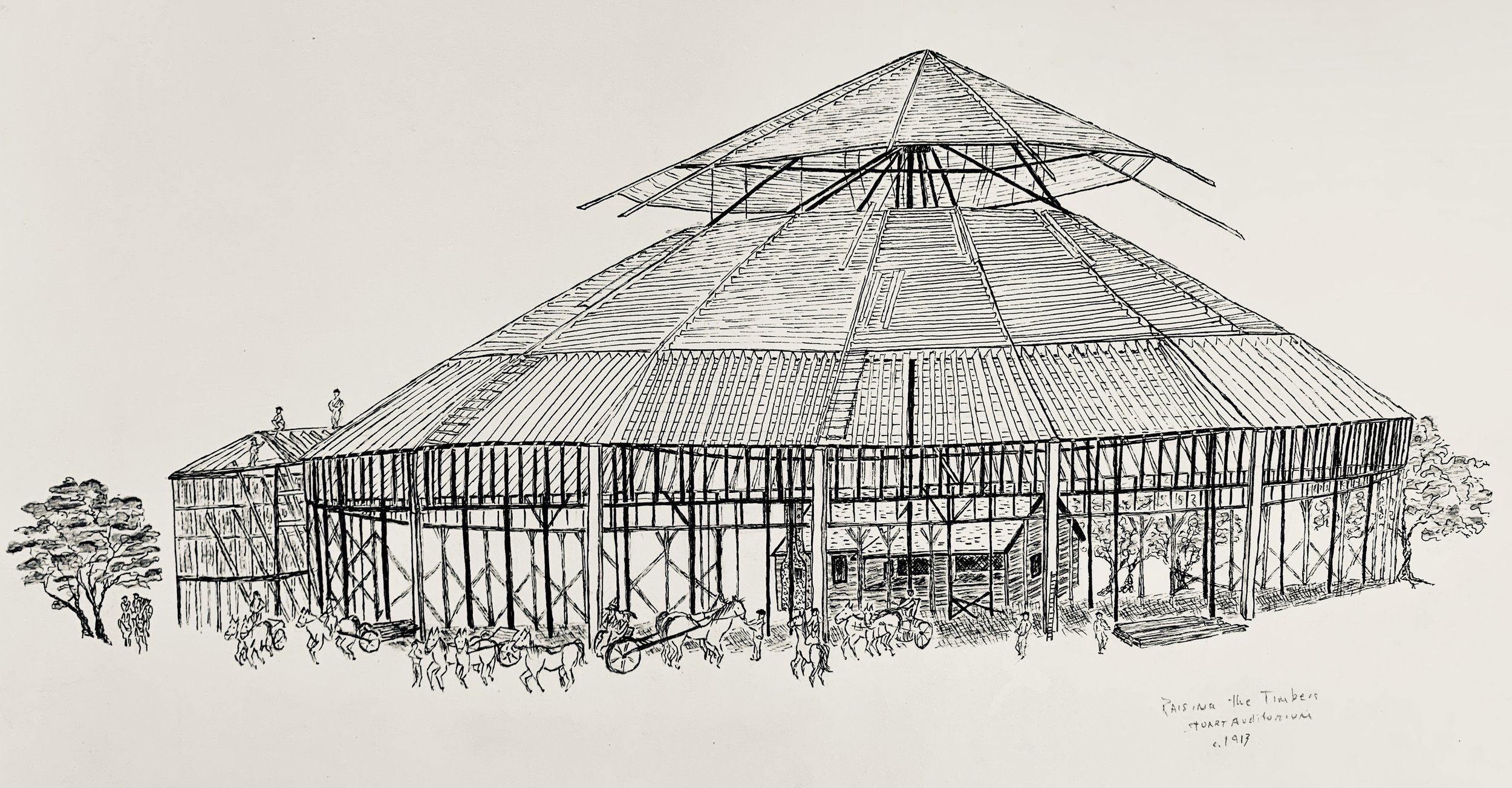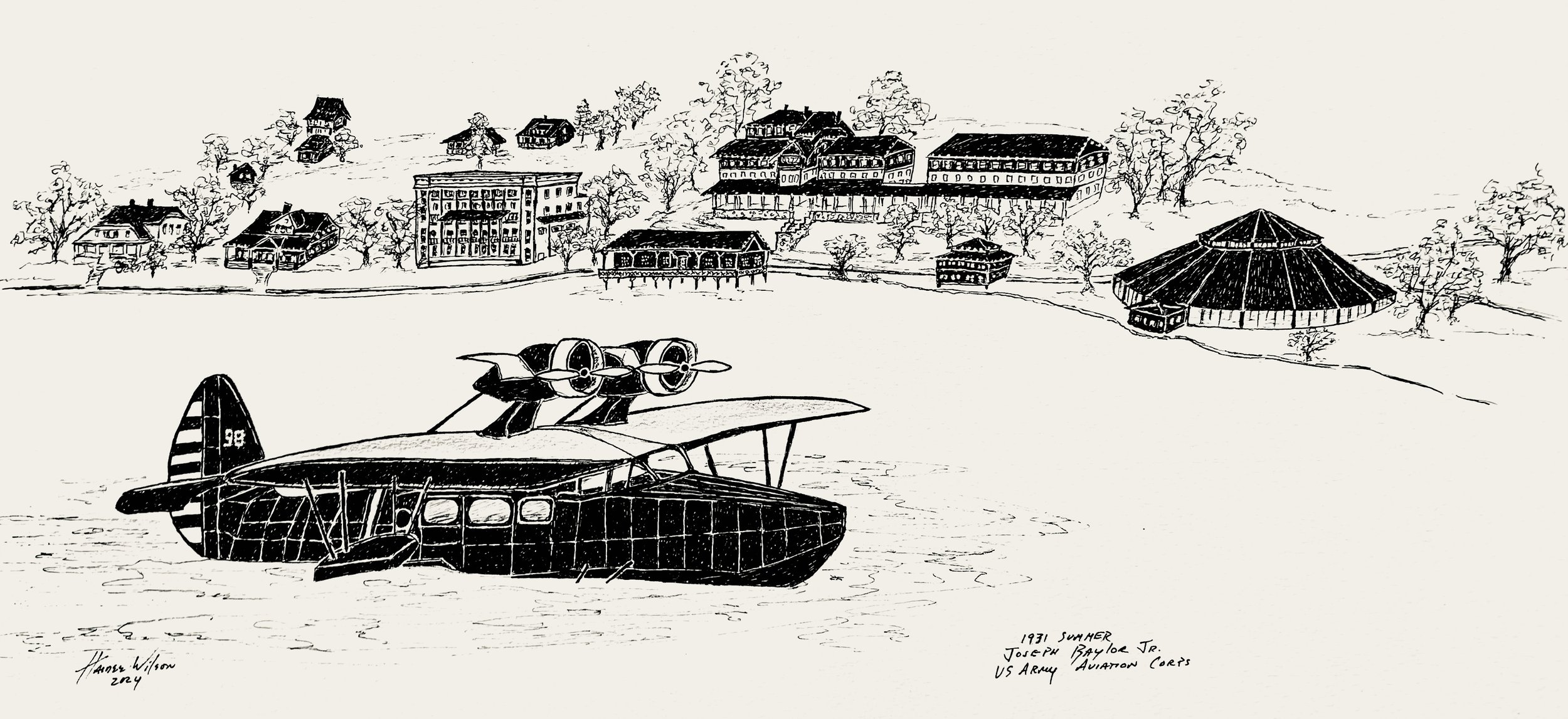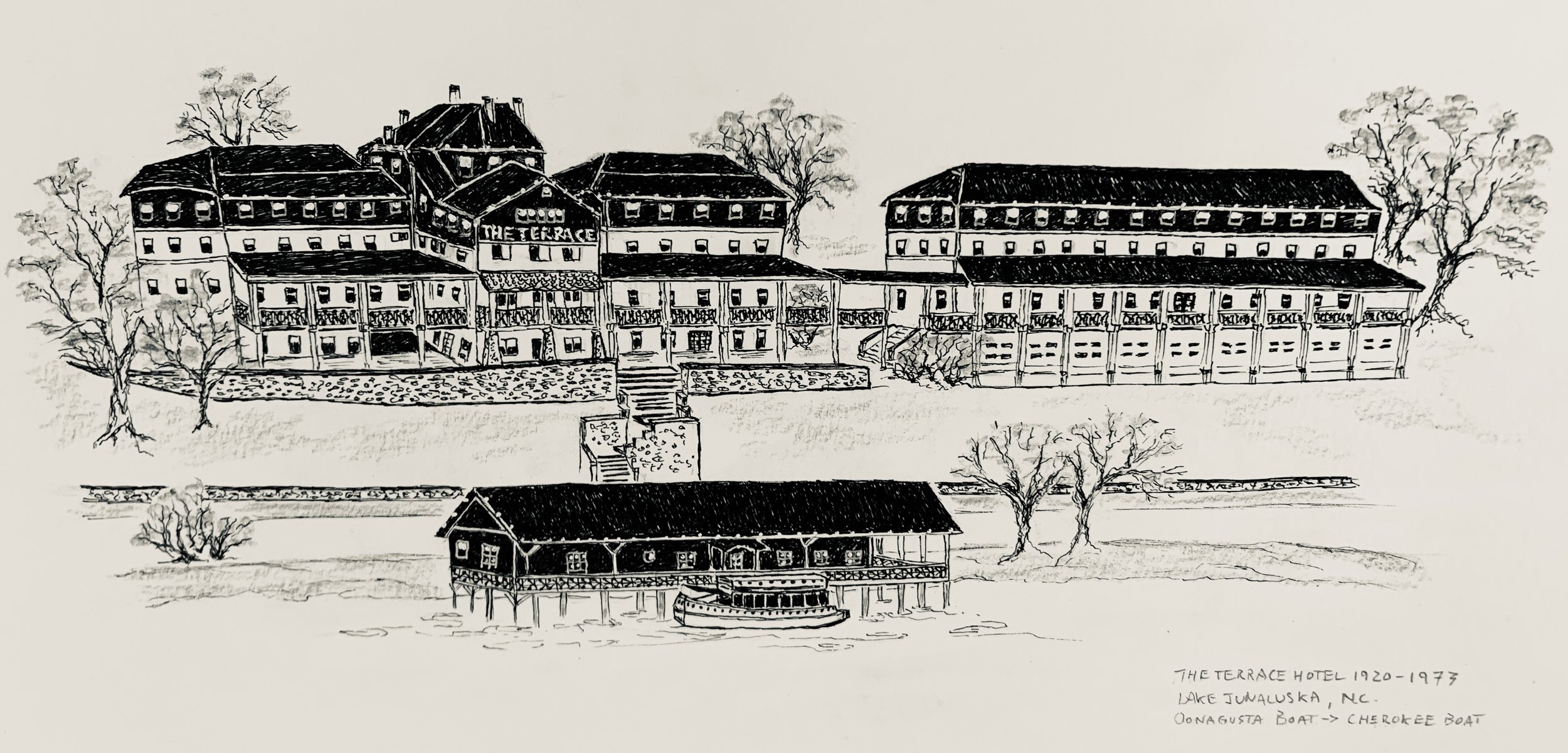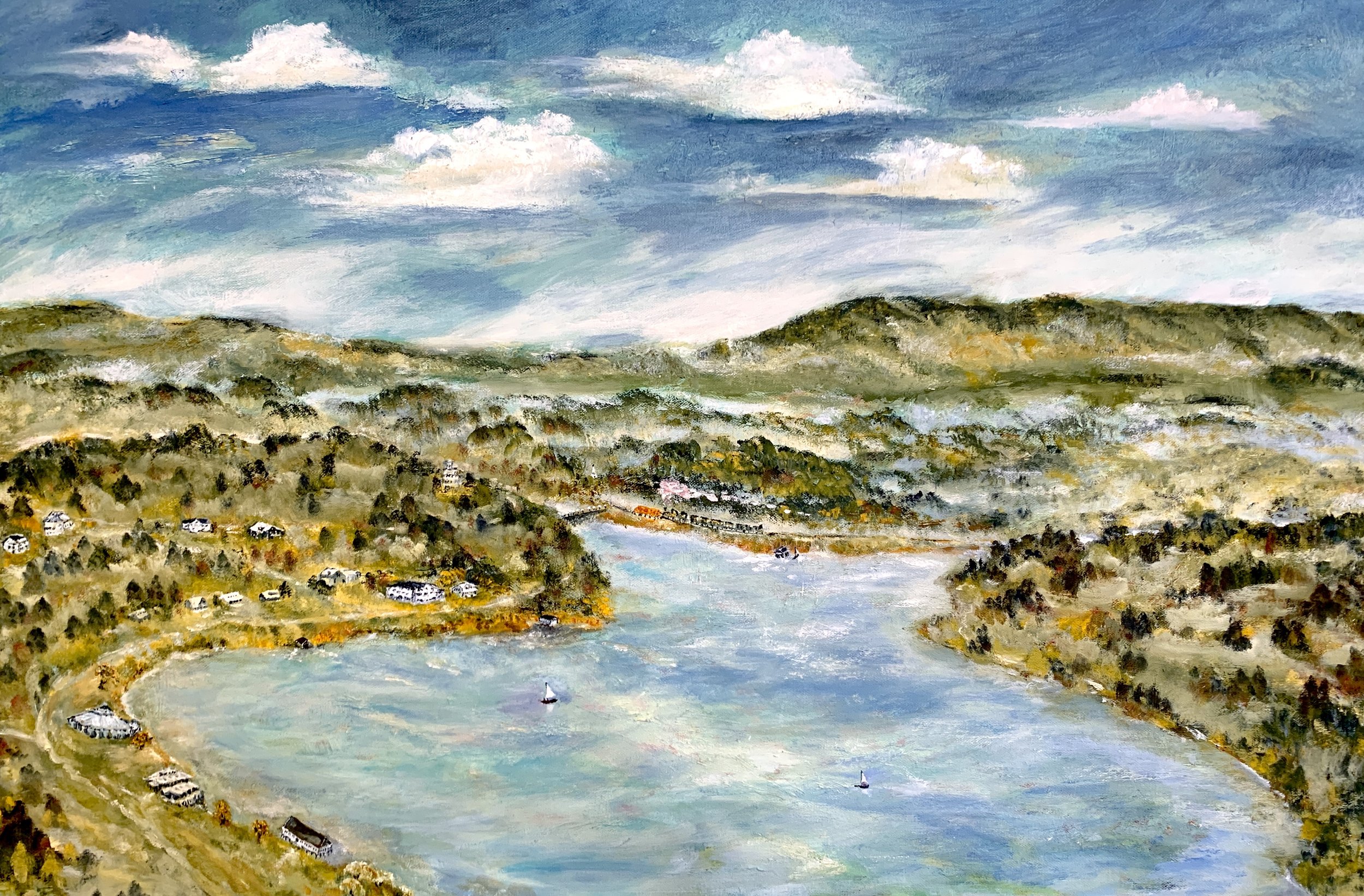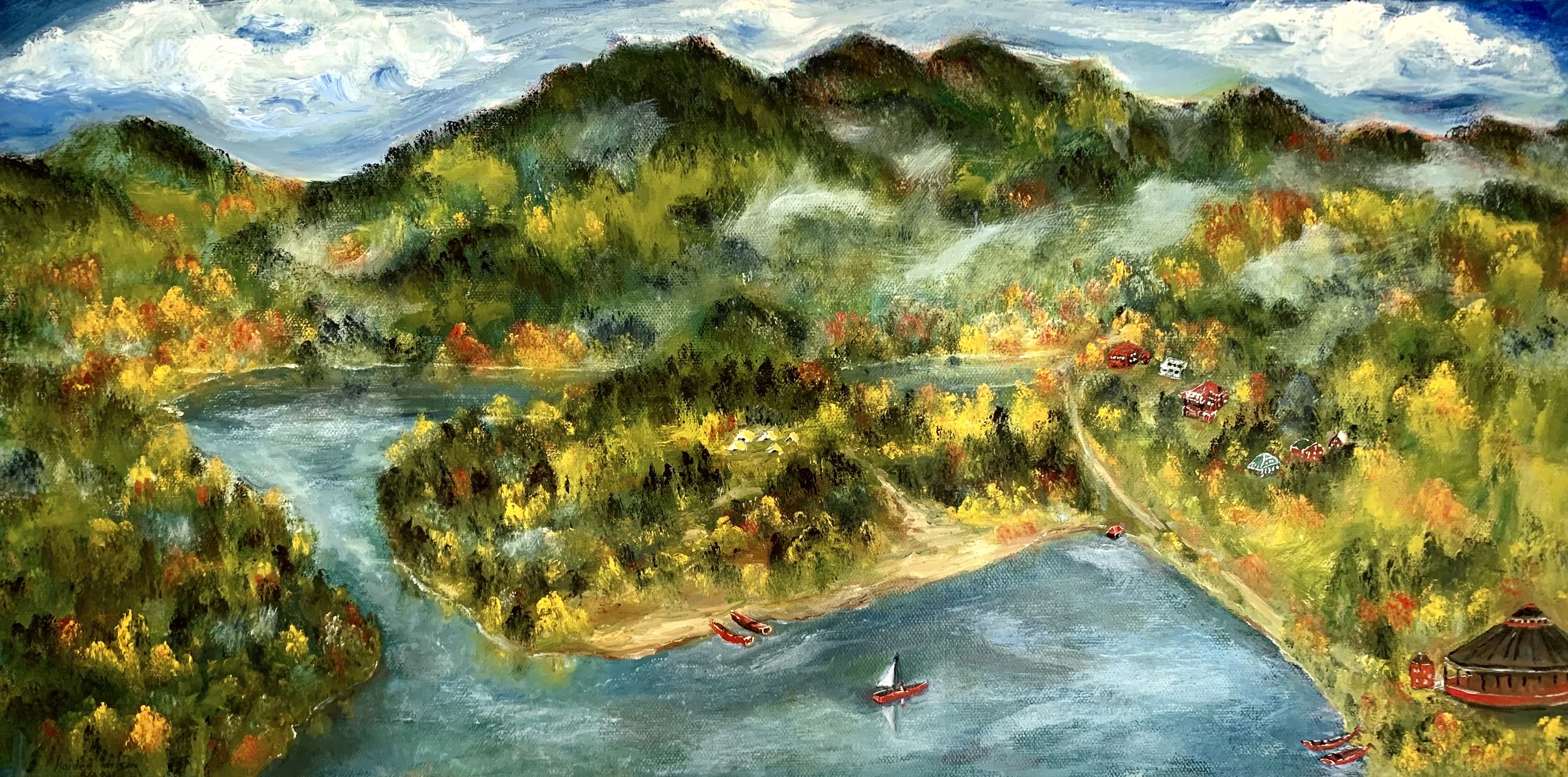
Welcome to a series of oil paintings and architectural ink designs on the history of Lake Junaluska
Richland Creek c.1912 prior to the dam at Lake Junaluska
Once inhabited by the Cherokee people this area was a part of the ancestral Cherokee territory in Western North Carolina. Richland Creek was in a valley made up of rich soil for growing crops and a vital water source for daily life in their settlements. During the "Trail of Tears" in the 1830s, the Cherokee were forcibly removed from their land, including the areas around Richland Creek, and relocated to Indian Territory west of the Mississippi River. Notably, "Mount Junaluska" (now North Eagle's Nest Mountain) near Lake Junaluska is named after a Cherokee leader, further signifying the Cherokee connection to the region. Lake Junaluska was formed by the damming of Richland Creek which originates in western Haywood County and flows into the Pigeon River. The lake depth at the dam is approximately 35-40 feet.
Early Boating at Lake Junaluska
Getting around the lake was by walking, horseback or boating across the lake. The early days the horse and buggy were few and treasured items.
Junaluska Mountain (Eagle’s Nest)
Eagle’s Nest Hotel 1900 - 1918
In1891 S.C. Satterthwaite bought a 204 acre tract of land on Junaluska Mountain (now known as Eagles Nest). Various oral histories say that groups of Cherokee Indians were hired to build the road to the top of the mountain. When large rocks were encountered, they would build fires and pour water on the rock to create fractures before busting them up. The progress of the road could be measured by how high up the mountain fires were located. The 5-mile road (a 3 hour ride) was open by the start of the 1898 tourist season, showing unsurpassed views.
The construction of the 40-room hotel having 3 large stone fireplace, a dining room able to hold a 100 guests and a roof top observatory started in 1899 by S.C. Satterthwaite. It opened in July 1900 as a very popular destination to get away from “Hay Fever Season” boasting 1000 guests in the 1903 season.
April 22, 1918 people in town noticed smoke coming from the hotel’s roof. By the time it was reached the whole building was engulfed in fire. The family was unable to recover financially from this devastating loss and decided not to rebuild.
Eagles Nest Road leads up to the original site, of which there’s a house built where the grand hotel once stood, and it’s hallway dotted in the hotel’s memory.
Junaluksa Mountain - abstract
Junaluska Inn
1917-1918
The Junaluska Inn was designed in the style of the grand hotels of the 1800s. It had a porch spanning from one end of the building to the other with all 130 rooms facing the lake with most having private baths. The inn opened, fully booked for the summer season, in June 1917. Its second summer season it burned to the ground in the early morning hours of July 17, 1918. The cause of the fire was never determined. Today’s Lambuth Inn stands on the site.
“ On the way to Sunday meetin’…”
“Raising the Timbers”
Stuart Center Auditorium - 1913
June 25th, 1913, at the opening at the first conference held at the Southern Assembly, the Auditorium was the first – and only – completed structure on the Assembly grounds. The sides were open, the bare ground was covered with sawdust, and the seating consisted of flat wooden benches. The auditorium had a seating capacity of 4000. Inspirational sermons and addresses were held. One could see the great beauty of distant mountains overshadowing the village of Waynesville. Birds chatter loudly coming freely in and out the auditorium. Sitting in the auditorium one could gaze upon beautiful mountain ranges, the Plott Balsams and to the West a crowning peak of Mount Junaluska now named Eagle’s Nest.
Visitors now enjoy it as a fully climate-controlled space with theater-style seating and excellent acoustics. Although the building has evolved over the years, the original “steel umbrella” design is still visible in the interior. It was renamed Stuart Auditorium in honor and memory of George R. Stuart, one of the founders of the Assembly, following his death in 1926.
Southern Railroad to Lake Junaluska
depot constructed in 1915
To and from Asheville via Southern Railroad had as much as 6 trips at the height of coming to Lake Junaluska. It served passengers for 50 years before ending in 1948. The passenger rail service in Haywood County was a thriving business, with stops in Frog Level in Waynesville, Clyde, Lake Junaluska and Canton. The Blue Ridge Southern Railroad now serves the area for freight.
It was not easy to cut this branch line through the mountains. If it had not been for the practical, self-educated engineer Capt. J. W. Wilson, a rigidly honest and industrious man, it might not have been accomplished for years. After iron rails reached Asheville in 1880, workers scattered to the west of the city, digging, filling, and blasting an extension of the line that stretched 116 miles to Murphy, providing thousands with a path to reach the outside world.
One of Capt. Wilson’s most challenging tasks was the grade on the west side of the Balsams that was steep and curvy, with gaping ravines. His second obstacle was the 836-foot Cowee Tunnel through a shaky mountain west of Dillsboro. High iron topped the Balsam Mountains at 3,100 feet, at the time the highest elevation of any railroad in the Eastern United States.
Summer 1931
Joseph Baylor Jr. of the US Army Aviation Corps landed his hydroplane on Lake Junaluska… paying a visit to his parents, the Rev. Joseph A. Baylor (1872-1947) an early leader in the spiritual enrichment at Lake Junaluska.
Asbury Trail in the Spring
Lake Junaluska
Francis Asbury, a leader in American Methodism, traveled the Cataloochee Trail in 1810 to spread the gospel in eastern Tennessee. The trail was used by early settlers and was once called a "turnpike". Asbury's journal recorded the difficulties of traveling the trail, which was rocky and treacherous.
Lake Junaluska has a paved walking trail, in memoriam, that boasts views of the lake for all to enjoy.
J.B. Ivey’s garden contained about 500 dahlia bushes blooming between July 1st to frost. The garden was open to the public at no charge. Mr. Ivey added a number of new varieties each year to his collection.
J.B. Ivey and family were the owners of the upscale Ivey’s department store, founded in 1900, based out of Charlotte, N.C., but having a store in Asheville (1926), later bought by Dillards, handed out a dahlia from his garden to each woman for purchasing a dress.
Dahlia gardens overlooking Lake Junaluska
J.B. Ivey’s Dahila Garden
Cherokee I / Oonagusta 1914
Originally christened the Oonagusta in 1914, the Cherokee I (also referred to as the Big Boat) transported guests and their luggage to and from the railroad depot on the south side of the lake to the hotels and homes on the north side. Moonlight cruises were popular as well, along with transportation from the boat house to the golf course. Today’s Cherokee IV provides guests with scenic tours of the lake.
Terrace Hotel 1914 - 1973
Construction of the original Terrace Hotel was begun in 1914 by Dr. J. M. Rhodes, president of Littleton College located in Littleton, NC. Initially named College Inn, construction stalled repeatedly due to insufficient funds. Following the loss of the Junaluska Inn by fire in 1918, the Junaluska Hotel Company purchased the College Inn property, completed construction, and renamed it the Terrace Hotel. The Terrace Hotel could not be adapted for year-round use, so, it was demolished in 1973 to make way for the current structure.
Colonial Inn, Lambuth Inn and train depot
*close-up of a larger painting
Colonial Inn Hotel - 1922
The Colonial Hotel was built by Mr. and Mrs. T. L. McLees and opened in 1922. The McLees operated the hotel until 1954. Lake Junaluska Assembly assumed ownership of the hotel in 1971. Many longtime residents of Lake Junaluska have fond memories of Sunday dinners served at the Colonial.
Lake Junaluska in all seasons










